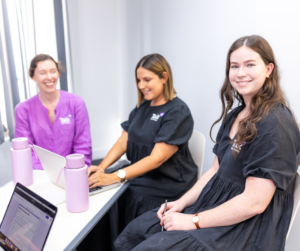In today’s digital age, it’s almost impossible to avoid screens entirely. From smartphones to tablets to TVs, screens are everywhere, and they often play a significant role in the lives of both adults and children. While technology can be a valuable tool for learning and entertainment, it’s essential for parents to strike a balance between screen time and face-to-face time, particularly for communication development in young children.
As speech pathologists, we know lots about the crucial role that talking and interaction have in a child’s development. Research has shown that early language skills are directly linked to later academic success and social-emotional well-being therefore, it’s important we bring awareness to the balance needed between screen time and time spent talking to your child.
Excessive screen time can have significant consequences for young children’s development across various domains. Firstly, it can lead to delayed language development as it limits opportunities for face-to-face communication which is a crucial aspect of language acquisition. Moreover, prolonged screen exposure often replaces social interaction, hindering the development of important communication skills like turn-taking and interpreting nonverbal cues.
Additionally, excessive screen time has been linked to impaired attention spans, as constant switching between apps and games can make it challenging for children to focus on activities requiring sustained attention, such as listening to stories or engaging in conversations. Lastly, exposure to screens before bedtime can disrupt sleep patterns due to the blue light emitted, affecting the production of melatonin and leading to difficulties falling and staying asleep, consequently impacting cognitive functioning and behavior during the day.
Here’s some practical tips for finding the right balance between screen time and face-to-face communication time for your child:
Set screen time limits
Establish clear guidelines for how much screen time is allowed each day, and stick to them consistently. The Australian Government Depart of Health and Aged Care recommends no more than one hour of screen time per day for children aged 3 to 5 years old.
Model healthy screen habits
Children learn by example, so be mindful of your own screen habits. Set a positive example by limiting your own screen time, especially when around your child. When you do use screens, involve your child in what you’re doing, whether it’s watching a family movie together or video chatting with loved ones.
Create screen-free zones for better communication
Designate certain areas of your home, such as the dinner table or the bedroom, as screen-free zones. Establishing boundaries around screen use can help reinforce the importance of face-to-face communication and foster a healthier balance between screen time and talking.
Encourage outdoor play to balance screen time
Make time for outdoor play and physical activity, which not only promotes overall health and well-being but also provides opportunities for language-rich experiences. Encourage your child to explore the natural world, engage in imaginative play, and interact with peers, all of which support language development in meaningful ways.
Read together to enhance language skills
Make reading a daily habit in your household by setting aside time to read together as a family. Choose a variety of books that cater to your child’s interests and developmental level, and make reading an interactive experience by asking questions, making predictions, and encouraging your child to retell the story in their own words.
In conclusion, while screens are a part of modern life, it’s essential for parents to be mindful of the impact excessive screen time can have on their language development. By setting clear limits and prioritising face-to-face interaction parents can help strike a healthy balance between balancing screen time and talking for language development for their young children. Remember, every moment spent engaging in meaningful conversation and interaction is an opportunity to support their language skills and set them on the path to success.
Check out our other blogs on our website.







